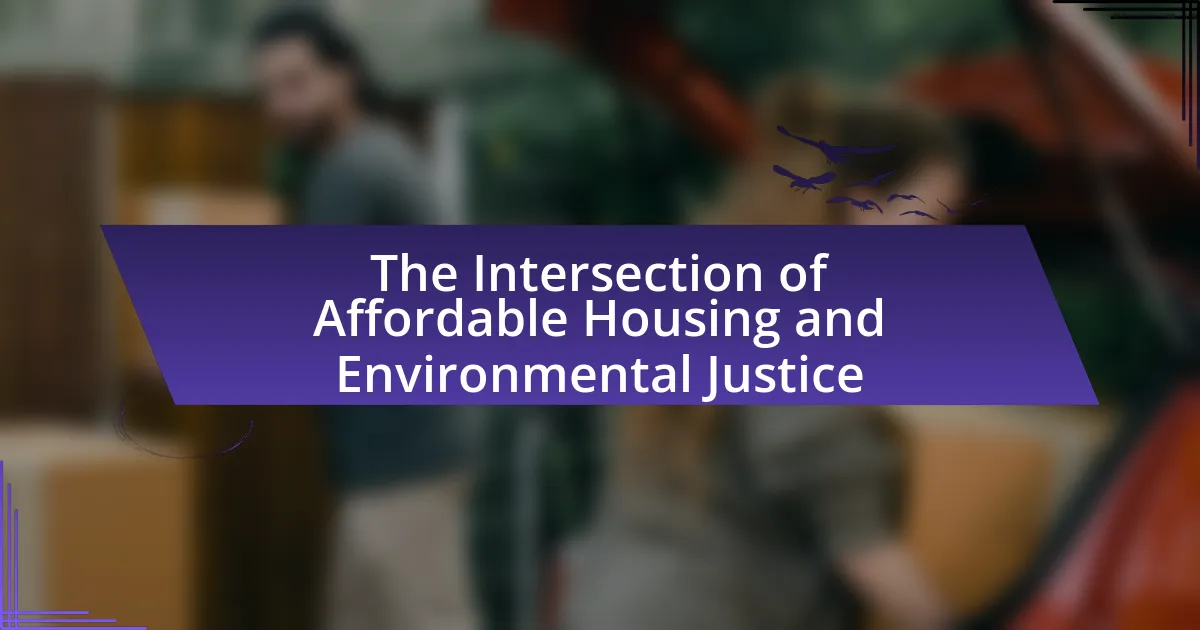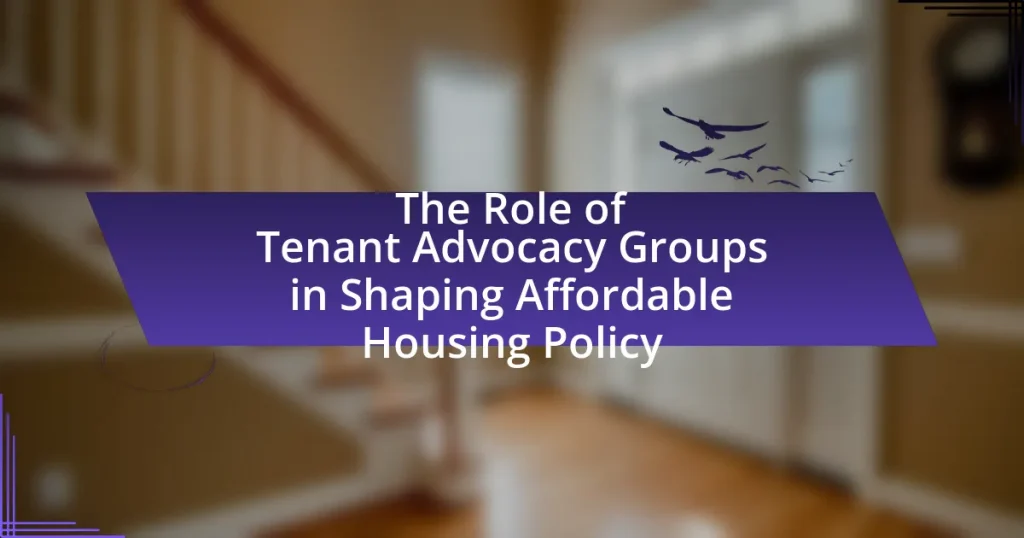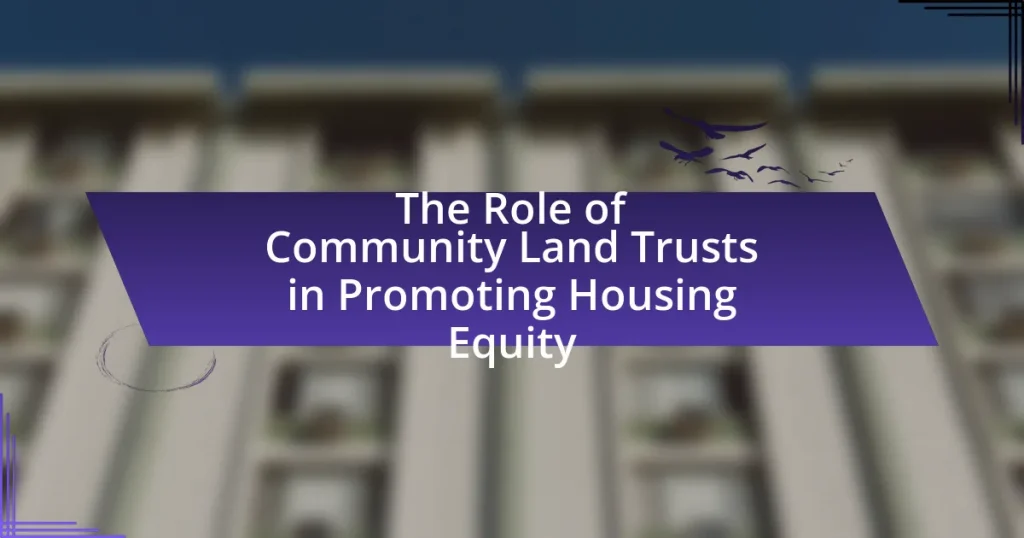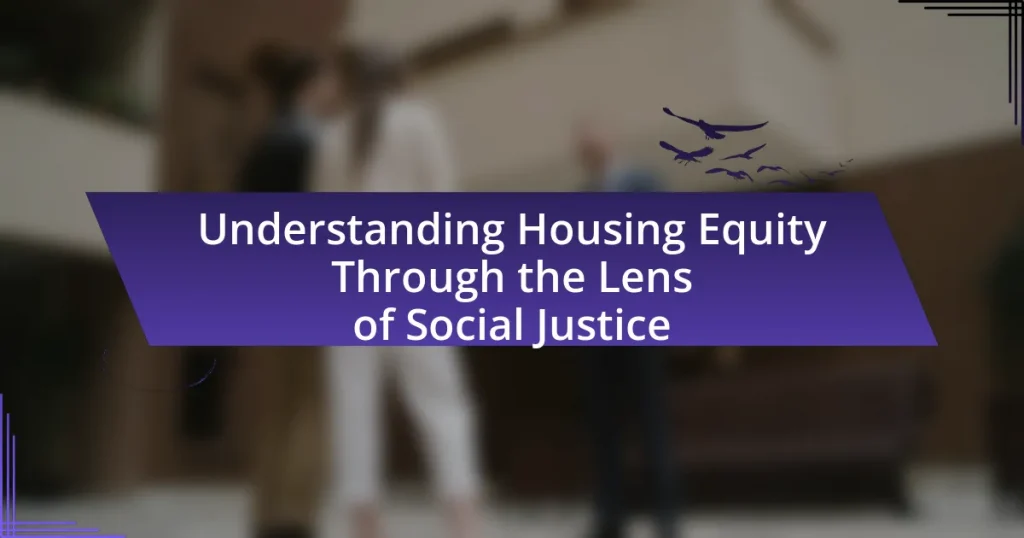The article examines the intersection of affordable housing and environmental justice, highlighting how low-income communities often endure disproportionate environmental hazards while lacking access to safe housing. It discusses the systemic inequalities that contribute to these challenges, including discriminatory policies and zoning laws that exacerbate health disparities. Key principles of affordable housing, such as accessibility and sustainability, are outlined alongside fundamental concepts of environmental justice, emphasizing the need for integrated policies that promote equitable living conditions. The article also addresses barriers to achieving environmentally just affordable housing and presents solutions, including community engagement and innovative practices that foster both housing equity and environmental sustainability.
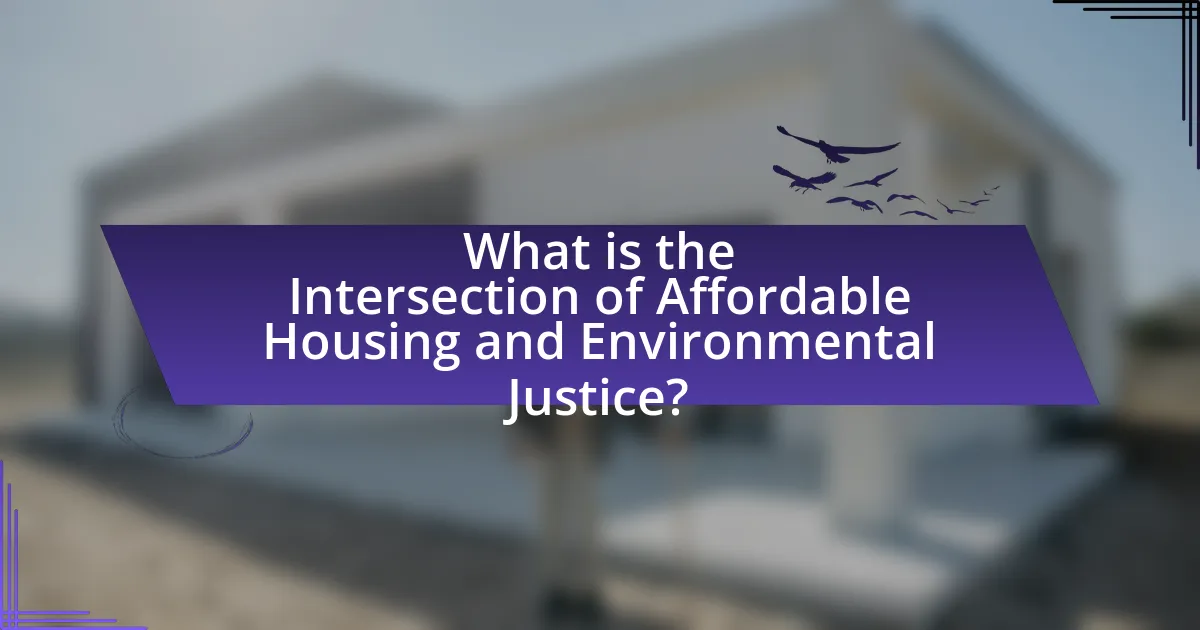
What is the Intersection of Affordable Housing and Environmental Justice?
The intersection of affordable housing and environmental justice lies in the recognition that low-income communities often face disproportionate environmental hazards while lacking access to safe and affordable housing. Research indicates that marginalized groups are more likely to reside in areas with higher pollution levels, which exacerbates health disparities. For instance, a study by the National Low Income Housing Coalition highlights that inadequate housing conditions can lead to increased exposure to environmental toxins, impacting residents’ health and well-being. This connection underscores the need for policies that integrate affordable housing development with environmental protections to ensure equitable living conditions for all communities.
How do affordable housing and environmental justice relate to each other?
Affordable housing and environmental justice are interconnected as both aim to address systemic inequalities affecting marginalized communities. Affordable housing initiatives often focus on providing safe, stable living conditions, which are essential for health and well-being. Environmental justice advocates for equitable distribution of environmental benefits and burdens, ensuring that low-income and minority communities are not disproportionately affected by pollution and environmental hazards. Research indicates that neighborhoods with affordable housing often face higher levels of environmental risks, such as proximity to industrial sites and lack of green spaces, which can exacerbate health disparities. Therefore, integrating affordable housing policies with environmental justice efforts can lead to healthier living environments and improved quality of life for vulnerable populations.
What are the key principles of affordable housing?
The key principles of affordable housing include accessibility, sustainability, and community integration. Accessibility ensures that housing is affordable to low- and moderate-income families, typically defined as spending no more than 30% of their income on housing costs. Sustainability focuses on creating housing that is environmentally friendly and energy-efficient, which can reduce long-term costs for residents. Community integration emphasizes the importance of affordable housing being located in areas with access to essential services, such as transportation, education, and healthcare, thereby promoting social equity. These principles are supported by various studies, including the National Low Income Housing Coalition’s report, which highlights the need for affordable housing to address economic disparities and improve community well-being.
What are the fundamental concepts of environmental justice?
The fundamental concepts of environmental justice include the fair distribution of environmental benefits and burdens, the recognition of the rights of marginalized communities, and the promotion of equitable participation in environmental decision-making processes. Environmental justice emphasizes that all individuals, regardless of race, income, or social status, should have equal access to a healthy environment and should not bear a disproportionate share of environmental hazards. This concept is supported by the 1991 Principles of Environmental Justice, which were established during the First National People of Color Environmental Leadership Summit, highlighting the need for systemic change to address environmental inequalities.
Why is the intersection of these two topics important?
The intersection of affordable housing and environmental justice is important because it addresses the dual challenges of providing equitable living conditions while ensuring sustainable environments for marginalized communities. Research indicates that low-income neighborhoods often face higher exposure to environmental hazards, which exacerbates health disparities. For instance, a study by the National Low Income Housing Coalition highlights that inadequate housing conditions can lead to increased vulnerability to climate change impacts, such as flooding and heatwaves. Therefore, integrating affordable housing initiatives with environmental justice principles is crucial for promoting both social equity and environmental sustainability.
How does affordable housing impact environmental justice?
Affordable housing significantly impacts environmental justice by promoting equitable access to safe and healthy living conditions for marginalized communities. When affordable housing is developed in environmentally safe areas, it reduces exposure to pollutants and enhances overall community health. For instance, studies show that low-income neighborhoods often face higher levels of environmental hazards, such as air and water pollution. By providing affordable housing in cleaner environments, these initiatives help mitigate health disparities and promote social equity. Furthermore, affordable housing projects that incorporate sustainable practices, such as energy efficiency and green spaces, contribute to environmental sustainability, benefiting both residents and the broader ecosystem.
What role does environmental justice play in the development of affordable housing?
Environmental justice plays a crucial role in the development of affordable housing by ensuring that marginalized communities have equitable access to safe and healthy living conditions. This principle addresses the disproportionate environmental burdens faced by low-income and minority populations, advocating for housing developments that are not only affordable but also free from environmental hazards such as pollution and toxic waste. Research indicates that neighborhoods with affordable housing often experience higher levels of environmental degradation, which can lead to health disparities. For instance, a study by the National Low Income Housing Coalition highlights that low-income communities frequently reside near industrial sites, increasing their exposure to harmful pollutants. Therefore, integrating environmental justice into affordable housing initiatives promotes sustainable development and improves the overall quality of life for vulnerable populations.
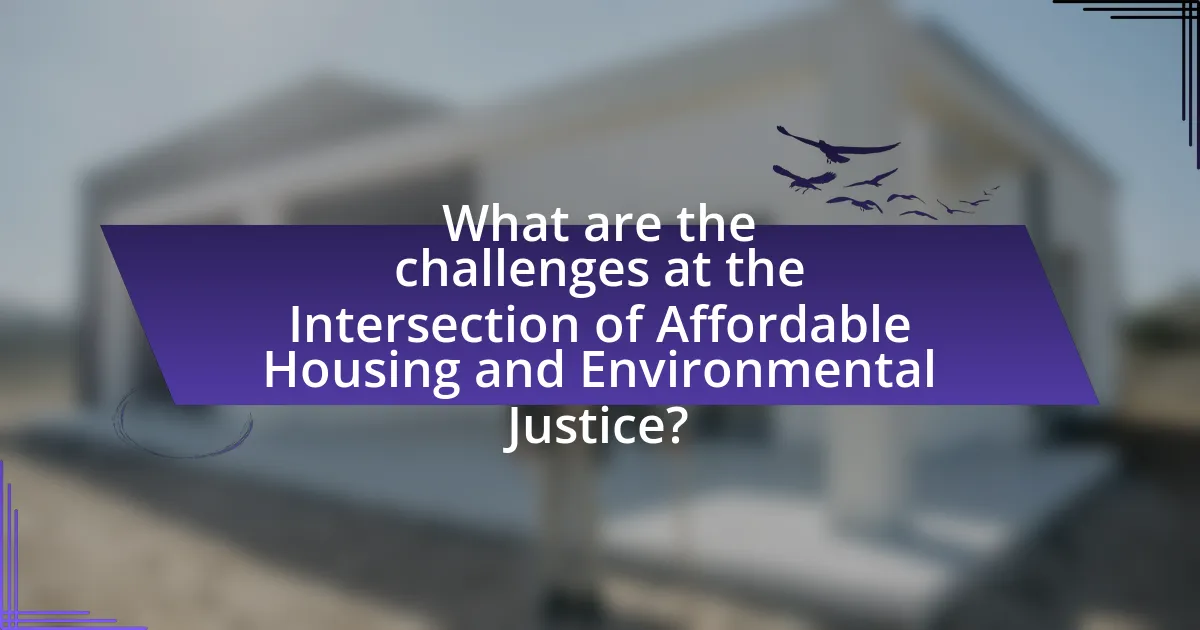
What are the challenges at the Intersection of Affordable Housing and Environmental Justice?
The challenges at the intersection of affordable housing and environmental justice include inadequate access to safe and healthy living conditions, increased exposure to environmental hazards, and systemic inequities in housing policies. Low-income communities often face higher pollution levels and lack essential services, which exacerbates health disparities. For instance, studies show that neighborhoods with affordable housing frequently coincide with industrial sites, leading to higher rates of respiratory illnesses among residents. Additionally, zoning laws and development practices can prioritize profit over community needs, further marginalizing vulnerable populations. These factors highlight the urgent need for integrated policies that address both housing affordability and environmental health to ensure equitable living conditions for all.
What barriers exist in achieving affordable housing that is environmentally just?
Barriers to achieving affordable housing that is environmentally just include regulatory constraints, financial limitations, and community opposition. Regulatory constraints often arise from zoning laws that prioritize high-income developments over affordable options, limiting the availability of land for low-income housing. Financial limitations stem from the high costs associated with sustainable building materials and technologies, which can deter developers from pursuing environmentally friendly projects. Community opposition, often referred to as NIMBYism (Not In My Backyard), can hinder the development of affordable housing in desirable areas, as residents may resist changes that they perceive as detrimental to their neighborhood. These barriers collectively impede the creation of housing that is both affordable and environmentally sustainable.
How do zoning laws affect affordable housing and environmental justice?
Zoning laws significantly impact affordable housing and environmental justice by regulating land use and development patterns. These laws can restrict the types of housing that can be built in certain areas, often favoring single-family homes over multi-family units, which limits the availability of affordable housing options. For instance, exclusionary zoning practices can lead to increased housing costs and displacement of low-income communities, exacerbating socioeconomic disparities. Additionally, zoning regulations can influence environmental justice by determining where low-income and minority populations can live, often placing them in areas with higher pollution levels and fewer resources. Studies, such as those conducted by the American Planning Association, indicate that inclusive zoning policies can promote equitable access to housing and improve environmental conditions for marginalized communities.
What are the economic challenges faced by communities in need of affordable housing?
Communities in need of affordable housing face significant economic challenges, including high housing costs, limited access to financing, and insufficient income levels. High housing costs often exceed the financial capabilities of low-income families, leading to a disproportionate burden on their budgets; for instance, the U.S. Department of Housing and Urban Development states that families should ideally spend no more than 30% of their income on housing. Limited access to financing restricts these communities from obtaining loans for home purchases or renovations, exacerbating the housing crisis. Additionally, insufficient income levels hinder residents’ ability to afford basic necessities, further complicating their housing situation. According to the National Low Income Housing Coalition, there is a shortage of 7 million affordable rental homes for extremely low-income renters, highlighting the urgent economic challenges these communities face.
How do systemic inequalities influence this intersection?
Systemic inequalities significantly influence the intersection of affordable housing and environmental justice by perpetuating disparities in access to safe and affordable living conditions. Communities marginalized by race, income, or social status often face higher exposure to environmental hazards, such as pollution and inadequate infrastructure, which exacerbates health issues and limits economic opportunities. For instance, studies show that low-income neighborhoods are frequently located near industrial sites, leading to increased health risks and reduced property values. This systemic neglect results in a cycle where disadvantaged groups struggle to secure affordable housing in healthier environments, further entrenching socio-economic disparities.
What historical factors contribute to the current state of affordable housing and environmental justice?
The historical factors contributing to the current state of affordable housing and environmental justice include discriminatory policies such as redlining, urban renewal projects, and zoning laws that have marginalized low-income communities and communities of color. Redlining, which began in the 1930s, systematically denied mortgage loans to residents in certain neighborhoods based on racial composition, leading to disinvestment and a lack of affordable housing options. Urban renewal initiatives in the mid-20th century often displaced these communities under the guise of development, exacerbating housing shortages and environmental degradation in areas where marginalized groups resided. Additionally, zoning laws have historically favored single-family homes and higher-income developments, limiting the availability of affordable housing and perpetuating socio-economic disparities. These factors collectively shape the ongoing challenges in achieving equitable access to housing and a healthy environment.
How do race and socioeconomic status affect access to affordable housing and environmental resources?
Race and socioeconomic status significantly affect access to affordable housing and environmental resources, with marginalized communities often facing greater barriers. Studies indicate that predominantly minority neighborhoods experience higher rates of housing instability and lower access to quality housing options, largely due to systemic discrimination and economic disparities. For instance, the Urban Institute found that Black and Hispanic households are disproportionately affected by housing cost burdens, with 50% of Black renters and 45% of Hispanic renters spending more than 30% of their income on housing, compared to 27% of white renters. Additionally, these communities frequently reside in areas with limited access to clean air, safe drinking water, and green spaces, as highlighted by the Environmental Protection Agency, which reports that low-income and minority populations are more likely to be located near hazardous waste sites. This intersection of race and socioeconomic status creates a cycle of disadvantage, limiting opportunities for upward mobility and overall well-being.

What are the solutions and best practices for addressing the Intersection of Affordable Housing and Environmental Justice?
Solutions and best practices for addressing the intersection of affordable housing and environmental justice include integrating sustainable building practices, ensuring equitable access to resources, and engaging communities in decision-making processes. Sustainable building practices, such as using energy-efficient materials and renewable energy sources, reduce environmental impact while lowering utility costs for residents. Equitable access to resources involves creating policies that prioritize affordable housing developments in areas with adequate infrastructure and services, thereby preventing displacement and promoting community stability. Engaging communities in decision-making ensures that the voices of marginalized populations are heard, leading to more inclusive and effective housing policies. For instance, the National Low Income Housing Coalition emphasizes the importance of community involvement in shaping housing policies to address both affordability and environmental concerns effectively.
What innovative approaches are being implemented to promote both affordable housing and environmental justice?
Innovative approaches to promote both affordable housing and environmental justice include the integration of green building practices in low-income housing developments and the establishment of community land trusts. Green building practices, such as using sustainable materials and energy-efficient designs, reduce environmental impact while lowering utility costs for residents. Community land trusts, which are nonprofit organizations that acquire and hold land for the benefit of the community, ensure long-term affordability and prevent displacement, thereby fostering both housing stability and environmental stewardship. These strategies are supported by policies that incentivize developers to incorporate sustainability measures in affordable housing projects, demonstrating a commitment to both social equity and ecological responsibility.
How can community engagement enhance the development of affordable housing?
Community engagement enhances the development of affordable housing by ensuring that the needs and preferences of local residents are prioritized in planning and design processes. Engaging the community fosters collaboration between developers, local governments, and residents, leading to solutions that are more likely to be accepted and supported. For instance, studies show that projects with strong community involvement tend to have higher rates of success and sustainability, as they reflect the actual demands and cultural contexts of the neighborhoods they serve. Additionally, community engagement can help identify potential funding sources and partnerships, as local stakeholders often have insights into available resources and can mobilize support for affordable housing initiatives.
What role do policy changes play in fostering environmental justice within affordable housing initiatives?
Policy changes are crucial in fostering environmental justice within affordable housing initiatives by ensuring equitable access to safe, healthy living conditions for marginalized communities. These changes can mandate the incorporation of sustainable building practices, improve access to green spaces, and enforce stricter regulations on pollution in low-income neighborhoods. For instance, the implementation of the Green New Deal in various states aims to address environmental disparities by promoting energy-efficient housing and reducing carbon footprints in underserved areas. Such policies not only enhance the quality of life for residents but also aim to rectify historical injustices related to environmental degradation in these communities.
What can individuals and organizations do to support this intersection?
Individuals and organizations can support the intersection of affordable housing and environmental justice by advocating for policies that promote sustainable development and equitable housing access. For instance, they can engage in community organizing to push for legislation that prioritizes green building practices in low-income neighborhoods, ensuring that affordable housing is not only accessible but also environmentally sustainable. Research indicates that sustainable housing can reduce energy costs and improve health outcomes for residents, thereby addressing both affordability and environmental concerns. Additionally, organizations can partner with local governments to create programs that provide financial incentives for developers to include green features in affordable housing projects, further reinforcing the connection between environmental justice and housing equity.
How can advocacy efforts influence policy for better affordable housing and environmental justice?
Advocacy efforts can significantly influence policy for better affordable housing and environmental justice by mobilizing community support, raising awareness, and providing data-driven recommendations to policymakers. For instance, organizations like the National Low Income Housing Coalition advocate for policies that increase funding for affordable housing programs, demonstrating through research that stable housing improves health outcomes and reduces environmental hazards. Furthermore, advocacy campaigns often highlight the disproportionate impact of environmental issues on low-income communities, compelling legislators to consider equity in housing and environmental regulations. This approach is supported by studies showing that inclusive policies lead to better community resilience and sustainability, ultimately shaping legislative priorities towards affordable housing and environmental justice.
What are some practical steps communities can take to improve both affordable housing and environmental conditions?
Communities can improve both affordable housing and environmental conditions by implementing mixed-use developments that integrate residential, commercial, and green spaces. This approach promotes efficient land use, reduces urban sprawl, and encourages sustainable transportation options, such as walking and cycling. For instance, cities like Portland, Oregon, have successfully utilized zoning laws to create mixed-use neighborhoods, resulting in increased housing availability and reduced carbon footprints. Additionally, communities can invest in energy-efficient building practices, such as using sustainable materials and incorporating renewable energy sources, which not only lower utility costs for residents but also minimize environmental impact. Research from the U.S. Green Building Council indicates that green buildings can reduce energy consumption by up to 30%, further supporting the dual goals of affordability and sustainability.
